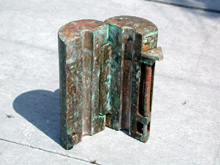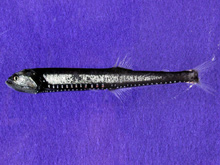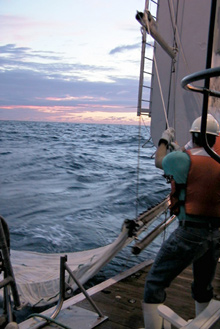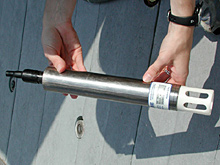Midwater Communities and Sampling
August 24, 2003
Ann Marie D. Necaise
Research Associate
North Carolina Coastal Reserve
One of the research goals for this mission is to determine the food web structure. Understanding food web structures can help us answer all kinds of questions, such as the availability of food in particular habitats, the feeding times and habits of particular species, and predator-prey roles. We are trying to discover the flow of energy throughout the entire water column, from surface to bottom. The midwater community provides an important link between these habitats, since most midwater fish make daily migrations between surface and bottom communities.
These fish are referred to as midwater fish because they spend most of their time migrating in midwater between surface and bottom communities, but don't reside full-time in either. During the day, these fish are found near the bottom. As the sun sets, they begin to move up in the water column, reaching the surface at night to feed. Near dawn, they begin their descent to the bottom, completing the daily cycle. In areas of significant depth, this is quite a feat. For people, it is the equivalent of running two marathons a day in less than 4 hours -- a total of 52.5 miles!
At the surface, midwater fish feed on plankton, crustaceans and fish. They then carry this energy to the bottom, where, through predation, the energy is transferred to bottom-dwelling fish and invertebrates. In deep-sea habitats, where food is often limited, midwater fish provide a great source of energy (food) to bottom communities.
To sample these midwater communities, researchers use nets known as Tucker trawls. Typically, we use these nets at night to capture midwater fish during their upward migration. The Tucker trawl consists of a net stretched between two steel bars, which filters samples into a small bucket. The net is attached to a wire on the ship and reeled out to a specific depth. We fish with the net for 30 minutes, then attach a brass block called the "messenger" to the wire and send it down to close the net. Once the net is pulled back up to the surface, the catch is examined. By closing the net with the “messenger” after fishing at the midwater level, we get a discrete sample of the water column at a known depth. This helps us to trace exactly where the migrating midwater fish are in the water column at a precise time.

Members of the science team attach a brass block called the "messenger" to the wire and send it down the line to close the trawl net. Click image for larger view.
Part of the difficulty in using these nets is calculating how much wire to let out in order to get the net to the specific depth you want. Unfortunately, the net doesn't just drop straight down below the ship. This is why a fisheries biologist needs to pay attention to those introductory physics classes they are required to take! The speed of the ship, current speed, wire angle, weight of the net, and bottom depth all interact to affect how much wire must be reeled out, and all of these components must be taken into account. Many of them change on a daily basis. For example, two nights ago, we let out 600 m of wire and only got the net down to 60 m. Last night, with the same amount of wire, the net reached a depth of 250 m -- quite a difference. This was most likely due to a change in the current speed, but many factors may have come into play.
To help researchers know precisely how deep a net is, we attach a temperature and pressure recorder to the top of the Tucker trawl; ours is called a Seabird 39. This device measures the temperature and pressure of the water every 5 sec while the net is fishing. From this, the depth can be calculated to determine exactly where the fish were being collected in the water column.
By piecing together the components of the midwater community and how it influences and is influenced by the surface and bottom communities, researchers can begin to view the puzzle that makes up the food web in deep-sea habitats.
From this, we gain a better understanding of the complexity of these systems.
























